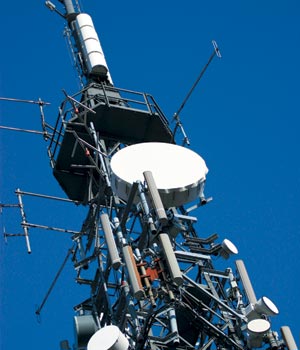|
Voice over Internet Protocol (VoIP) is a general term for a family of transmission technologies for delivery of voice communications over the Internet or other packet-switched networks. Other terms frequently encountered and synonymous with VoIP are IP telephony and Internet telephony, as well as voice over broadband, broadband telephony, and broadband phone, when the network connectivity is available over high speed Internet access. VoIP systems usually interface with the traditional public switched telephone network (PSTN) to allow for transparent phone communications worldwide. VoIP can be a benefit for reducing communication and infrastructure costs by routing phone calls over existing data networks and avoiding duplicate network systems. Skype and Vonage are notable service provider examples that have achieved widespread user and customer acceptance and market penetration.Voice-over-IP systems carry telephony speech as digital audio, typically reduced in data rate using speech data compression techniques, packetized in small units of typically tens of milliseconds of speech, and encapsulated in a packet stream over IP.There are two types of PSTN-to-VoIP services: Direct inward dialing (DID) and access numbers. DID will connect a caller directly to the VoIP user, while access numbers require the caller to provide an extension number for the called VoIP user.
|
|
Voice-over-Internet Protocol has been a subject of interest almost since the first computer network. By 1973, voice was being transmitted over the early Internet. The technology for transmitting voice conversations over the Internet has been available to end-users since at least the early 1980s. In 1996, a shrink-wrapped software product called VocalTec Internet Phone (release 4) provided VoIP along with extra features such as and . However, it did not offer a gateway to the PSTN, so it was only possible to speak to other Vocaltec Internet Phone users. In 1997, Level 3 began development of its first softswitch (a term they invented in 1998); softswitches were designed to replace traditional hardware telephone switches by serving as gateways between telephone networks. Revenue in the total VoIP industry in the US is set to grow by 24.3% in 2008 to $3.19 billion. Subscriber growth will drive revenue in the VoIP sector, with numbers expected to rise by 21.2% in 2008 to 16.6 million. The United States' largest VoIP provider is Vonage .
|
|
VoIP can facilitate tasks and provide services that may be more difficult to implement or more expensive using the PSTN. Examples include:
|
|
Because UDP does not provide a mechanism to ensure that data packets are delivered in sequential order, or provide Quality of Service (QoS) guarantees, VoIP implementations face problems dealing with latency and jitter. This is especially true when satellite circuits are involved, due to long round-trip propagation delay (400–600 milliseconds for links through geostationary satellites). The receiving node must restructure IP packets that may be out of order, delayed or missing, while ensuring that the audio stream maintains a proper time consistency. This function is usually accomplished by means of a jitter buffer in the voice engine.
Many VoIP providers do not decode pulse dialing from older phones. The VoIP user may use a pulse-to-tone converter, if needed. Fixed delays cannot be controlled but some delays can be minimized by marking voice packets as being delay-sensitive. The principal cause of packet loss is congestion, which can sometimes be managed or avoided. Carrier VoIP networks avoid congestion by means of teletraffic engineering. RELIABILITY Conventional phones are connected directly to telephone company phone lines, which in the event of a power failure are kept functioning by backup generators or batteries located at the IP Phones and the IP infrastructure connect to (routers and servers), which typically depend on the availability of mains electricity or another locally generated power source. Therefore, most VoIP networks and the supporting routers and servers are also on widely available and relatively inexpensive Uninterrupted Power Supply (UPS) systems to maintain electricity during a power outage for a predetermined length of time. The amount of time typically ranges from as little as an hour and up from there, depending on the quality of the UPS unit and the power draw and characteristics of the communications equipment. Some broadband connections may have less than desirable quality. Where IP packets are lost or delayed at any point in the network between VoIP users, there will be a momentary drop-out of voice. This is more noticeable in highly congested networks and/or where there are long distances and/or interworking between end points. Technology has improved the reliability and voice quality over time and will continue to improve VoIP performance as time goes on.
|
| HOME VOIP IP PHONE FOIP CDMA WCDMA |
| CATEGORY |
|---|
 |
 |
|---|
 |
|---|
 |
 |